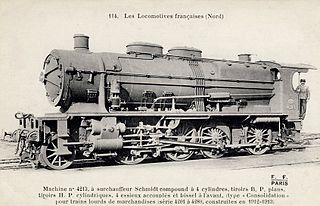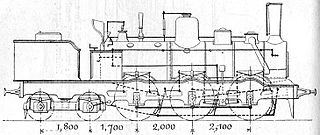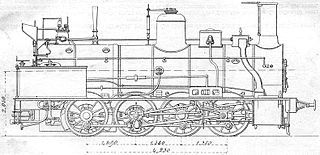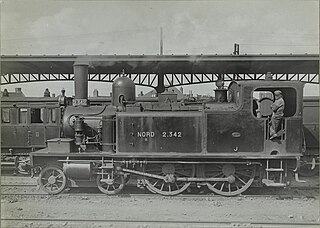| Nord 2.821 to 2.911 and 2.201 to 2.212 | |||||||||||||||||||||||||
|---|---|---|---|---|---|---|---|---|---|---|---|---|---|---|---|---|---|---|---|---|---|---|---|---|---|
 | |||||||||||||||||||||||||
| |||||||||||||||||||||||||
| |||||||||||||||||||||||||
| |||||||||||||||||||||||||
The Nord 2.821 to 2.911 and 2.201 to 2.212, also referred to as Outrances, was a series of French 2-4-0 and 4-4-0 express passenger locomotives of the Chemins de Fer du Nord .
| Nord 2.821 to 2.911 and 2.201 to 2.212 | |||||||||||||||||||||||||
|---|---|---|---|---|---|---|---|---|---|---|---|---|---|---|---|---|---|---|---|---|---|---|---|---|---|
 | |||||||||||||||||||||||||
| |||||||||||||||||||||||||
| |||||||||||||||||||||||||
| |||||||||||||||||||||||||
The Nord 2.821 to 2.911 and 2.201 to 2.212, also referred to as Outrances, was a series of French 2-4-0 and 4-4-0 express passenger locomotives of the Chemins de Fer du Nord .

The first series, Nord 2.821–2.832, designed by L. Beugniot as 2-4-0 locomotives, was built by André Koechlin & Cie in Mulhouse in 1870–1871. [1] The locomotive had a double frame with two driving axles and a leading axle which had a clearance of 10 mm (0.39 in) on each side. [2] The firebox had an arced top and sat between the two driving axles. The tubes had a length of 3.17 m (10.4 ft) and the boiler barrel consisted of two boiler shells, with a boiler pressure of 8.5 kg/cm2 (0.834 MPa; 121 psi). The dome was placed centrally on top of the firebox and a Crampton-type steam regulator was placed on the extreme front of the first boiler shell. The cylinders were installed horizontally without inclination inside of the frame and had a Stephenson valve gear. The two-axle tender used had a capacity of 8 m3 (280 cu ft) water and 3 t (6,610 lb) coal and weighed a total of 21.6 t (47,600 lb).
In 1873 Édouard Delebecque modified the design. A Belpaire firebox which extended over the rear driving axle was installed. [1] The tubes were lengthened to 3.55 m (11.6 ft) and the dome was moved slightly forward to the front on top of the firebox. A single machine, the Nord 2.833, was built in 1873. [3]
From 1875 to 1877 the next series, Nord 2.834–2.860, was built by the Société Alsacienne de Constructions Mécaniques (SACM) at Mulhouse with only minor differences. [1] The dome was moved forward to the rear end of the second boiler shell, just in front of the firebox. [3] Also a three-axle tender of 14 m3 (490 cu ft) water and 4 t (8,820 lb) coal, weighing 33 t (72,800 lb), was used.
In the following series, Nord 2.861–2.911, which was built in 1877–1879, the leading axle was replaced by a 2-axle bogie pivoting around a fixed point in the frame. [1] [3] Also the boiler pressure was increased to 10 kg/cm2 (0.981 MPa; 142 psi).
The last series was built in the years 1884 to 1885 and comprised the twelve locomotives Nord 2.201–2.212, which had a leading radial axle instead of the 2-axle bogie. [1]
Over time various modifications were done on the machines. All machines with a single leading axle received leading 2-axle bogies with lateral movement, the Nord 2.821–2.833 in 1890–1892, the Nord 2.834–2.860 in 1894–1898 and the Nord 2.201–2.212 in 1891–1892. [1] Additionally a Belpaire firebox was installed on most of the Nord 2.821–2.832 series, a spherical dome was mounted on top of the boiler barrel, and the boiler pressure was increased to 10–11 kg/cm2 (0.981–1.08 MPa; 142–156 psi).
In 1885–1890 the locomotives of the series Nord 2.833–2.860 also had their boiler pressure increased to 8.5–10 kg/cm2 (0.834–0.981 MPa; 121–142 psi) and Nord 2.847, 2.850 and 2.851 to 11 kg/cm2 (1.08 MPa; 156 psi). [1] Some of the machines, called Outrances renforcées, also received cylinders with an increased size of 460 mm × 610 mm (18+1⁄8 in × 24 in). [1]

Under the Whyte notation for the classification of steam locomotives, a 2-10-4 locomotive has two leading wheels on one axle, usually in a Bissel truck, ten coupled driving wheels on five axles, and four trailing wheels on two axles, usually in a bogie. These were referred to as the Texas type in most of the United States, the Colorado type on the Burlington Route, and the Selkirk type in Canada.

A high-pressure steam locomotive is a steam locomotive with a boiler that operates at pressures well above what would be considered normal for other locomotives. Most locomotives operate with a steam pressure of 200 to 300 psi. In the later years of steam, boiler pressures were typically 200 to 250 psi. High-pressure locomotives can be considered to start at 350 psi (2.41 MPa), when special construction techniques become necessary, but some had boilers that operated at over 1,500 psi (10.34 MPa).

Nord 4.061 to 4.340 were a class of 2-8-0 tender goods locomotives of the Chemins de fer du Nord. At nationalisation on 1 January 1938 they all passed to the SNCF who renumbered them 2-140.A.1 to 2-140.A.280.

SNCF 232.P.1 was an experimental prototype high-pressure steam locomotive ordered by the Chemins de fer du Nord, but delivered to the Société nationale des chemins de fer français (SNCF) in 1939. It was the first and only member of SNCF's first class of 4-6-4 or Hudson type of locomotives.
The SNCF 232.Q.1 was an experimental prototype steam locomotive of the Société nationale des chemins de fer français (SNCF) which entered service in 1940. It was Baltic or 4-6-4 locomotive.
The Alsace-Lorraine A 2 was a class of German 2-4-0 express passenger locomotives. In 1906 the Imperial Railways in Alsace-Lorraine reclassified them as P 2.

Nord 3.401 à 3.512 were 0-6-0 locomotives for mixed traffic of the Chemins de Fer du Nord. The locomotive class served for more than 50 years, with the last locomotive, Nord 3.486, retiring in 1936.

Nord 2.451 to 2.631 were 0-4-2 locomotives for mixed traffic of the Chemins de Fer du Nord. The machines were retired from service from 1909 to 1923.

Nord 3.021 to 3.075 were 0-6-4 tank locomotives for mixed traffic of the Chemins de Fer du Nord.
Est 441 to 485 was a class of 45 French 0-4-2 locomotives for mixed service, built in 1885 for the Chemins de fer de l'Est. They were the final development of the 0-4-2 locomotive in France.

Nord 4.001 to 4.075 and 4.636 to 4.990, also called 180 unités, were 0-8-0 locomotives for freight traffic of the Chemins de Fer du Nord.

Est 501 to 562 was a class of 62 French 2-4-0 locomotives for express passenger service, built in 1878–1886 for the Chemins de fer de l'Est.

Nord 3.606 to 3.787 were 0-6-0 locomotives for mixed traffic of the Chemins de Fer du Nord. The machines were the continuation of the Nord 265 to 274 (3.265–3.274) Mammouth locomotives of 1849, and hence were also referred to by the same nickname. They were retired from service from 1910 until end of 1930.
Est 0.1 to 0.120 were 0-6-0 locomotives for mixed traffic of the Chemins de fer de l'Est. They were retired from service from 1891 until 1928.
Est 0.189 to 0.200 were 0-6-0 locomotives for freight traffic of the Chemins de fer de l'Est. They were put in service in 1857 and were retired until 1928.
Nord 401 to 436, renumbered to Nord 2.401 to 2.436 in 1872, were 0-4-6T Engerth locomotives for mixed traffic of the Chemins de Fer du Nord. The machines were built in 1856–1857 and retired from service in the early 1900s.
Nord 360 to 399, renumbered to Nord 4.361 to 4.400 in 1872, were 0-8-4T Engerth locomotives for freight traffic of the Chemins de Fer du Nord. The machines were built in 1856–1857 and retired from service in 1907–1910.

Nord 2.311 to 2.380, were 4-4-0T locomotives for suburban passenger traffic of the Chemins de Fer du Nord. The machines were built in 1892–1893. They were nicknamed "Ravachol" because of the entry into service of the series when the latter was arrested in April 1892.

The Belgian State Railways Type 1 was a class of 2-4-0 steam locomotives for passenger service, introduced in 1864.

The Belgian State Railways Type 12 was a class of 2-4-2 steam locomotives for express passenger service, introduced in 1888. They were the successors of the Belgian State Railways Type 1 locomotives.